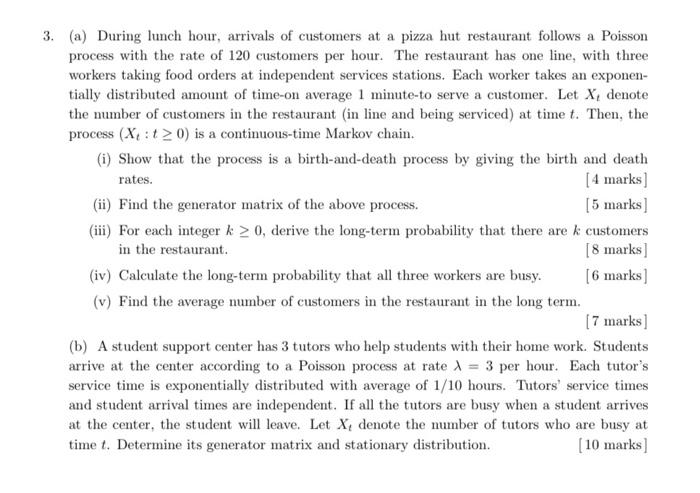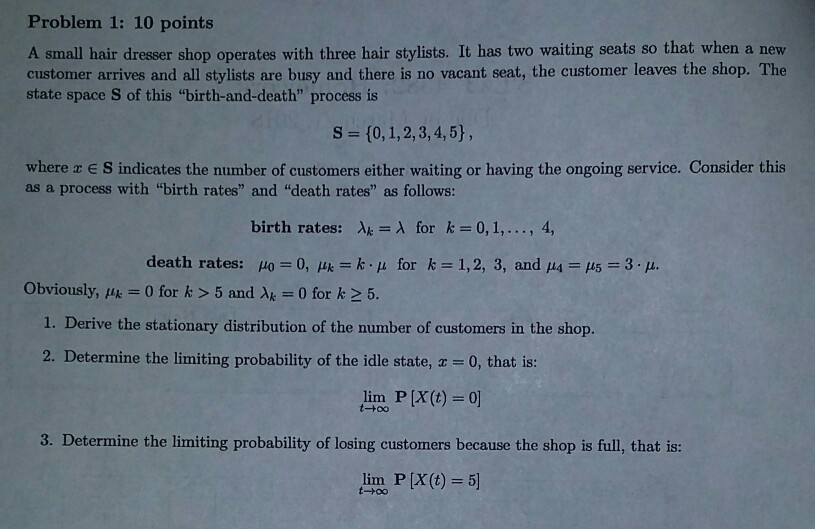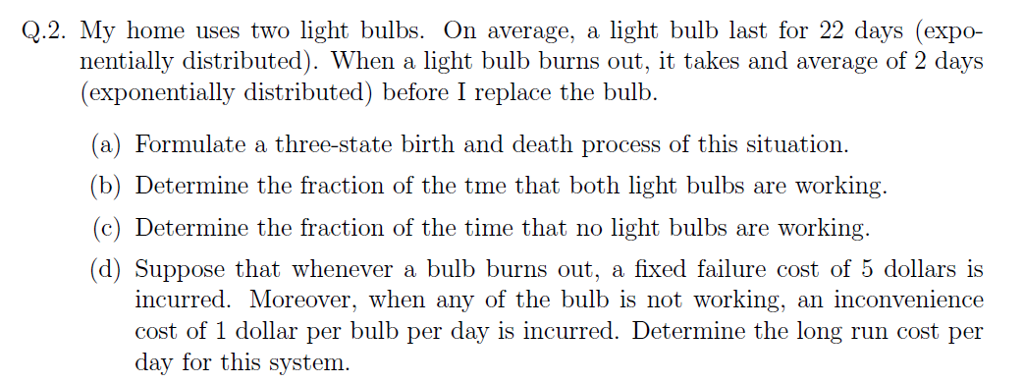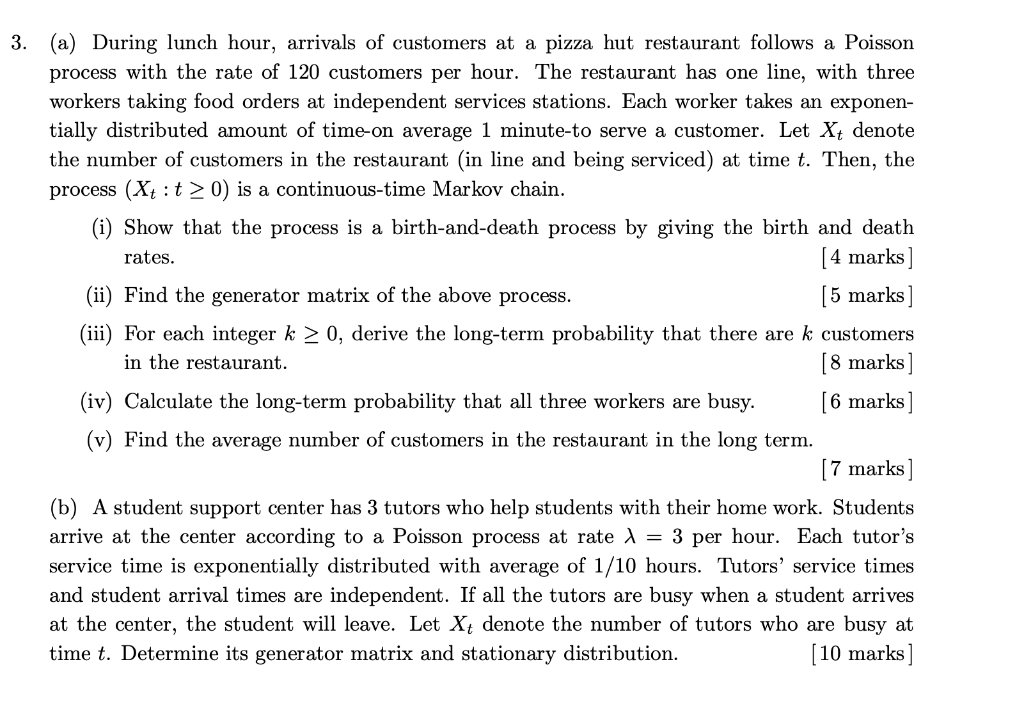3. (a) During lunch hour, arrivals of customers at a pizza hut restaurant follows a Poisson process with the rate of 120 customers per hour. The restaurant has one line, with three workers taking food orders at independent services stations. Each worker takes an exponen- tially distributed amount of time-on average 1 minute-to serve a customer. Let X, denote the number of customers in the restaurant (in line and being serviced) at time t. Then, the process (Xt : 1 2 0) is a continuous-time Markov chain. (i) Show that the process is a birth-and-death process by giving the birth and death rates. [4 marks] (ii) Find the generator matrix of the above process. [5 marks] (iii) For each integer & 2 0, derive the long-term probability that there are & customers in the restaurant. [8 marks] (iv) Calculate the long-term probability that all three workers are busy. [6 marks] (v) Find the average number of customers in the restaurant in the long term. [7 marks ] (b) A student support center has 3 tutors who help students with their home work. Students arrive at the center according to a Poisson process at rate A = 3 per hour. Each tutor's service time is exponentially distributed with average of 1/10 hours. Tutors' service times and student arrival times are independent. If all the tutors are busy when a student arrives at the center, the student will leave. Let X, denote the number of tutors who are busy at time t. Determine its generator matrix and stationary distribution. [10 marks]Problem 1: 10 points A small hair dresser shop operates with three hair stylists. It has two waiting seats so that when a new customer arrives and all stylists are busy and there is no vacant seat, the customer leaves the shop. The state space S of this "birth-and-death" process is S = {0, 1, 2, 3, 4, 5} , where a E S indicates the number of customers either waiting or having the ongoing service. Consider this as a process with "birth rates" and "death rates" as follows: birth rates: Ak = A for k = 0, 1, ..., 4, death rates: /0 = 0, #x = k . u for k = 1, 2, 3, and #4 = 45 = 3 . H. Obviously, /k = 0 for k > 5 and Ak = 0 for k 2 5. 1. Derive the stationary distribution of the number of customers in the shop. 2. Determine the limiting probability of the idle state, x = 0, that is: lim P [X(t) = 0] 1 -+ 0o 3. Determine the limiting probability of losing customers because the shop is full, that is: lim P [X(t) = 5] 1-tooQ2. My home uses two light bulbs. On average, a light bulb last for 22 days (expo- nentially distributed). When a light bulb burns out, it takes and average of 2 days (exponentially distributed] before I replace the bulb. (a) Formulate a three-state birth and death process of this situation. (b Determine the fraction of the trne that both light bulbs are working. ) ((3) Determine the fraction of the time that no light bulbs are working. ) ((1 Suppose that Whenever a bulb burns out, a fixed failure cost of 5 dollars is incurred. Moreover, when any of the bulb is not working, an inconvenience cost of 1 dollar per bulb per day is incurred. Determine the long run cost per day for this system. 3. (3.) During lunch hour, arrivals of customers at a pizza hut restaurant follows a Poisson process with the rate of 120 customers per hour. The restaurant has one line, with three workers taking food orders at independent services stations. Each worker takes an exponen- tially distributed amount of time-on average 1 minute-to serve a customer. Let Xt denote the number of customers in the restaurant (in line and being serviced) at time t. Then, the process (X: : t 2 0) is a continuous-time Markov chain. (1) Show that the process is a birth-and-death process by giving the birth and death rates. :4 marks] (ii) Find the generator matrix of the above process. :5 marks] (iii) For each integer k 2 0, derive the long-term probability that there are in customers in the restaurant. :8 marks] (iv) Calculate the long-term probability that all three workers are busy. :6 marks] [v] Find the average munber of customers in the restaurant in the long term. :7 marks] (b) A student support center has 3 tutors who help students with their home work. Students arrive at the center according to a Poisson process at rate A = 3 per hour. Each tutor's service time is exponentially distributed with average of 1/10 hours. Tutors' service times and student arrival times are independent. If all the tutors are busy when a student arrives at the center, the student will leave. Let Xt denote the number of tutors who are busy at time t. Determine its generator matrix and stationary distribution. [10 marks]










